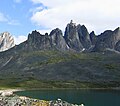Mount Monolith
| Mount Monolith | |
|---|---|
 Summit centered, west aspect | |
| Highest point | |
| Elevation | 2,165 m (7,103 ft)[1] |
| Prominence | 444 m (1,457 ft)[2] |
| Parent peak | Tombstone Mountain[3] |
| Isolation | 4.43 km (2.75 mi)[2] |
| Coordinates | 64°25′36″N 138°31′35″W / 64.42667°N 138.52639°W[4] |
| Naming | |
| Etymology | Monolith |
| Geography | |
| Location | Yukon, Canada |
| Protected area | Tombstone Territorial Park[3] |
| Parent range | Ogilvie Mountains[2] |
| Topo map | NTS 116B7 Tombstone River |
| Geology | |
| Age of rock | Cretaceous |
| Type of rock | Granite |
Mount Monolith is a mountain in Yukon, Canada.
Description[edit]
Mount Monolith is a 2,165-metre-elevation (7,103-foot) summit located in the Ogilvie Mountains and within Tombstone Territorial Park. It ranks as the sixth-highest mountain in the Ogilvie Mountains.[2] Precipitation runoff from the remote peak drains into the Tombstone River and North Klondike River which are both part of the Yukon River watershed.[2] Topographic relief is significant as the summit rises 725 metres (2,380 feet) above the Tombstone River in less than two kilometres (1.2 mile). The nearest road is the Dempster Highway 11 km (7 mi) to the southeast, and the nearest town is Dawson, 60 km (37 mi) to the southwest.[4] Based on the Köppen climate classification, Mount Monolith is located in a subarctic climate zone with long, cold, winters, and short, mild summers.[5] Winter temperatures can drop below −40 °C with wind chill factors below −50 °C. The toponym was officially adopted on July 30, 1968, by the Geographical Names Board of Canada.[4]
See also[edit]
Gallery[edit]
References[edit]
- ^ "Mount Monolith". Bivouac.com. Retrieved 2024-01-22.
- ^ a b c d e "Mount Monolith, Yukon Territory". Peakbagger.com. Retrieved 2024-01-22.
- ^ a b Mount Monolith, Peakvisor.com, Retrieved 2024-01-22.
- ^ a b c "Mount Monolith". Geographical Names Data Base. Natural Resources Canada. Retrieved 2024-01-22.
- ^ Peel, M. C.; Finlayson, B. L.; McMahon, T. A. (2007). "Updated world map of the Köppen−Geiger climate classification". Hydrol. Earth Syst. Sci. 11. ISSN 1027-5606.
External links[edit]
- Mount Monolith: Weather forecast
- Mount Monolith (photo): Flickr




